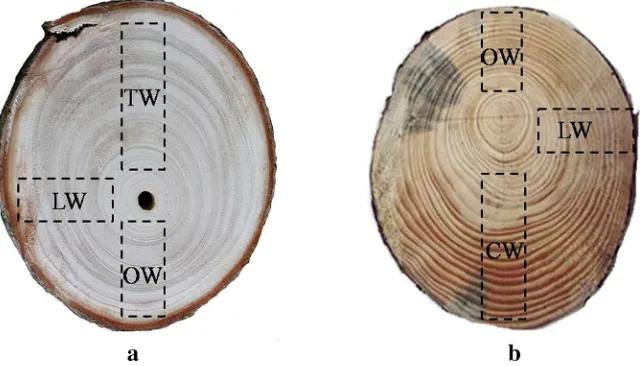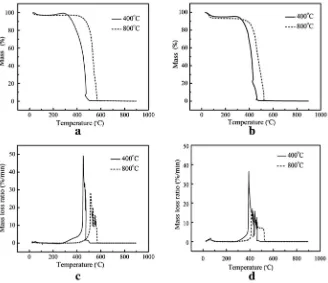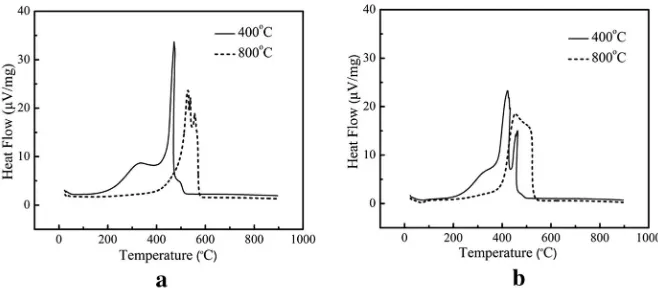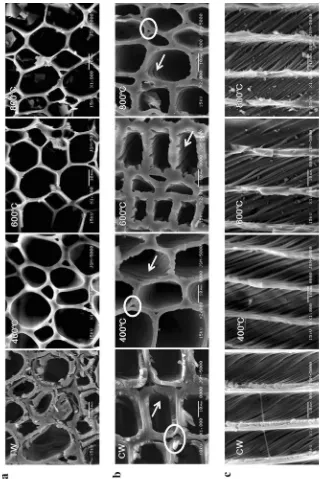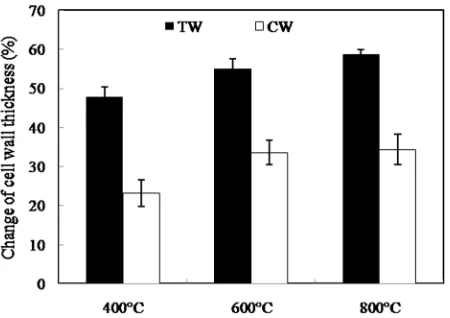O R I G I N A L
Carbonization of reaction wood from
Paulownia
tomentosa
and
Pinus densiflora
branch woods
Yue Qi1•Jae-Hyuk Jang1,2•Wahyu Hidayat1,3•
Ae-Hee Lee1•Seung-Hwan Lee1• Hee-Mun Chae1•
Nam-Hun Kim1
Received: 13 October 2015 / Published online: 7 May 2016
ÓSpringer-Verlag Berlin Heidelberg 2016
Abstract The carbonization characteristics of tension wood (TW) and compression wood (CW) from Paulownia tomentosa and Pinus densiflora branch woods, respectively, were investigated and compared to those of opposite wood (OW) and lateral wood (LW). The carbonization was conducted at 400, 600, and 800°C.
Heating values, pH, char yields, cell wall structures, and combustion characteristics were different in TW and CW, whereas only little differences were found among reaction wood, OW, and LW. The heating values of TW charcoal were lower than those of CW charcoal at 400 and 600°C, while the pH of TW charcoal was higher
than that of CW at all carbonization temperatures. The char yields of CW were the highest among all the samples at all carbonization temperatures. Furthermore, the TW charcoal was more thermally stable than CW charcoal. SEM observations revealed significant differences in the cell wall structures of the woods before and after carbonization. The gelatinous layer in TW disappeared, and the helical cavities and intercellular spaces in CW persisted throughout the carbonization process. The cell wall structures of the wood samples became smooth and amorphous as the carbonization temperature increased.
& Nam-Hun Kim
1
College of Forest and Environmental Sciences, Kangwon National University, Chuncheon 24341, Republic of Korea
2 The Institute of Forest Science, Kangwon National University, Chuncheon 24341, Republic of
Korea
3 Department of Forestry, Faculty of Agriculture, Lampung University, Bandar Lampung,
Indonesia
Introduction
Charcoal as fuel has been conventionally applied to many fields, such as soil modification, water and air purification, and smelting, and has recently refocused as solid bio-energy. Wood, woody materials, woody wastes, agricultural wastes, herbaceous plants, and biosolids are useful raw materials for charcoal production.
Many studies have been conducted to optimize carbonization conditions such as temperature for wood charcoal production and have investigated carbonization characteristics. Slocum et al. (1973) and Cutter and McGinnes (1981) have extensively investigated the density change patterns in charred wood. According to Slocum et al. (1973), the densities of oak and hickory charcoals were significantly lower than those of the raw woods and were maximized at 600°C. Cutter and
McGinnes (1981) reported that the density of seven wood species charcoal decreased as the temperature increased to 600°C, and the maximum rate of density
change was observed between 300 and 350°C. Anatomical changes of the vessel
diameter, cell wall thickness, crystalline structure, and morphology in woods subjected to carbonization were also reported by previous studies. McGinnes et al. (1971), Kim and Hanna (2006) and Kumar and Gupta (1995) studied the morphological changes of wood charcoal using scanning electronic microscope (SEM). Elyounssi and Halim (2014) and Kwon et al. (2009) reported the dimensional shrinkage and crystalline structure by an X-ray diffraction analysis. Cutter et al. (1980) and Kwon et al. (2014) demonstrated the difference in cell wall thickness before and after carbonization.
The chemical properties of charcoal have been studied in terms of ash chemical composition, element content, and ultimate and proximate analyses (Kumar et al.
2009; Liu et al.2014; Somerville and Jahanshahi2015). Yang et al. (2007) reported the degradation of chemical functional groups and a comprehensive understanding of the pyrolysis of cellulose, hemicelluloses, and lignin with focus on the gas product releasing properties. The pH change in wood charcoal as a function of the carbonization temperature was also evaluated by Jo et al. (2009) and Kai et al. (2000). They found that the pH was changed from acidic to basic as the carbonization temperature increased.
Wood industry has mainly used stem wood, and most of the branches, especially branch reaction wood, have been wasted. Reaction wood is undesirable in any structural application, because it can twist, cup, or warp dramatically during machining. Previous studies showed that the wood material containing reaction wood had a reduced compressive and bending strength and a very low modulus of elasticity in bending (Furuno et al.1969). Therefore, efficient ways of utilizing the branch wood need exploring.
knowledge and searching. Furthermore, there is no available information, regarding the carbonization characteristics of the cellulose-rich TW and lignin-rich CW.
Paulownia tomentosais a fast-growing wood species with intensive branches, and Pinus densiflora is one of the most common wood species in Korea. In a previous study (Qi et al. 2014), the difference of the anatomical and physical properties between TW, OW, and LW ofPaulownia coreanawas investigated to contribute to efficient utilization of branch woods. This study investigated the carbonization characteristics of branch wood, including reaction wood, to facilitate its utilization as a carbonized material. The heating values, pH, char yields, pyrolysis characteristics, and morphological changes of reaction wood charcoal fromP. tomentosaandP. densiflorawere examined.
Materials and methods
Materials
Branch woods ofP. tomentosaandP. densiflorawere obtained from the Research Forest of Kangwon National University (N 37°510/E 127°480) in South Korea.
Air-dried wood samples fromP. tomentosawere categorized into TW, OW, and LW, and those fromP. densiflorawere categorized into CW, OW, and LW, as shown in Fig.1.
Wood charcoal production
Air-dried wood samples were cut into small blocks with dimension of 29294 cm3. The prepared small blocks were carbonized in an electric furnace
(HT 16/16, Supertherm, Germany) under nitrogen atmosphere (1 kg/cm2) at 400, 600, and 800°C. The carbonization was performed with a heating rate of 6°C/min
from ambient temperature to the final target temperature. Once the final carbonization temperature (400, 600, or 800°C) was reached, the wood samples
were kept for 10 min at that temperature and then rapidly buried in cooling sand.
Methods
Measurement of the heating value, pH, char yield, chemical components, and proximate analysis
The heating value was measured with 0.5 g of oven-dried powder using an oxygen bomb calorimeter (Parr 6300 calorimeter) in accordance with the Korean standard (KS E 37072001).
For pH measurement, oven-dried powder samples (1 g) were mixed with 100 ml of distilled water and boiled for 10 min. After cooling to room temperature, the pH of the supernatant solution was determined with a pH meter (InoLab, pH Level 2).
The charcoal yield was estimated by the following equation:
Yieldð%Þ ¼W2
W1
100 ð1Þ
whereW1(g) is the oven-dried weight of the wood sample andW2(g) is the
oven-dried weight of the charcoal.
For the proximate analysis, ash content, volatile matter content (VMC), and fixed carbon content (FCC) were measured according to the KS standard (KS E ISO 562
2012; KS E ISO 1171 2012).
All the measurements were repeated five times.
The holocellulose and lignin content of TW and CW were determined by using standard methods as follows: Wood power samples were extracted using ethanol– benzene solution; the extractive-free powder samples were delignified using NaClO2–acetic acid treatment (Kumar et al. 2013); holocellulose in the wood
samples was calculated using delignified powder samples according to standard method (TAPPI1992); and the lignin contents were measured using extractive-free powder samples with 72 % sulfuric acid solution for 2 h (Dence1992).
Thermogravimetric analysis (TGA) and differential scanning calorimeter (DSC)
The combustion of wood charcoal prepared from TW and CW at 400 and 800°C,
respectively, was carried out with a TGA Q600 analyzer (TA instrument, USA) under air atmosphere in the KNU Center for Research Facilities. This instrument provides simultaneous measurement of weight change (TGA) and differential heat flow (DSC). Powdered samples of ca.10 mg were continuously examined under dynamic heating conditions from ambient temperature to 900°C with a heating rate
Scanning electron microscopy (SEM)
Samples with dimension of 10 mm (R)910 mm (T) 95 mm (L) were prepared, and smooth surfaces were obtained using a sliding microtome. The samples were coated with gold using a Gressington sputter coater (ULVAC G-50DA, Japan) and observed with a scanning electron microscope (JEOL, JSM-5510, 15–20 kV, Japan). The changes in the cell wall dimensions were measured from SEM images using Total Imaging Solution (IMT, I-solution Lite).
Results and discussion
Heating value
Table1 shows the heating values of branch woods from P. tomentosa and P. densiflora. The heating value of all samples increased as the carbonization temperatures increased. As the temperature increased to 800°C, the heating values
of samples increased from 18.0 to 34.0 kJ/g. It has been known that volatile matter, such as H2O, CO, CO2, and CH4, is more released as carbonization temperatures
increased during the carbonization process, resulting in the increase in fixed carbon content (FCC) and decrease in volatile matter content (VMC) (Han and Kim2006; Kumar and Chandrashekar2013; Liu et al.2014). Han and Kim (2006) reported that the heating values of carbonized Korean red pine at 400 and 600°C were 29.45 and
34.76 MJ/kg and that carbon content increased from 75.68 to 87.97 %, respectively. Kumar and Chandrashekar (2013) observed that the heating value of samples increased from 19.15 to 31.74 MJ/kg as the temperature increased from the ambient temperature to 600°C, whereas the FCC increased from 17.38 to 81.19 %, and the
VMC decreased from 80.39 to 14.79 %. Liu et al. (2014) showed that the carbon content of charcoal exhibited a linear relationship with the heating value and the carbon content increased from 49.59 to 74.56 % as the heating value increased from 18.52 to 27.09 kJ/g. Phan et al. (2008) also reported that the heating values of waste
Table 1 Heating values of branch woods fromPaulownia tomentosaandPinus densifloraat different temperatures
Experimental temperature (°C)
Heating value (kJ/g)
Paulownia tomentosa Pinus densiflora
TW* OW* LW* CW* OW* LW*
wood, cardboard, and textile increased as the carbonization temperature increased from 350 to 700°C. Moreover, Kumar et al. (2009) found that C–O bonds and C–H
bonds have lower energy than C–C bonds, and the energy value of biomass is increased when the contents of oxygen and hydrogen are lower. Therefore, the heating value should increase as the number of C–C bonds, which have relatively high energy, increases.
In this study, the heating value increased significantly from ambient temperature to 400°C but increased only slightly from 600 to 800°C (Table1). The change in
heating value can be affected by increase in ash content and FCC and decrease in the VMC as increasing the carbonization temperatures (Table2). Moreover, heating value of CW was found to be only slightly different to that of TW. The difference in the biomass energy may be attributable to the major biochemical constituents, which include cellulose, hemicelluloses, and lignin. It is known that lignin has a heating value of approximately 27.0 MJ/kg, which is higher than that of cellulose (17.3 MJ/kg) (Kaltschmitt et al.2009; Yang et al. 2007). The contents of lignin might have a considerable influence on the heating value. Demirbas (2001) also indicated that the heating value of the biomass fuel had highly significant linear correlation with its lignin content, where higher lignin content resulted in higher heating value. Related to this present study, the heating value of CW charcoal was slightly higher than that of TW charcoal. It could be related to different ash contents and VMCs of TW and CW charcoals, since the chemical components had decomposed after carbonization. Consequently, it is considered that heating value could be affected by the content of lignin, ash, volatile matter, and fixed carbon.
pH
The pH values of the raw wood and wood charcoal are listed in Table3. The pH of all raw wood samples was weakly acidic around pH 5, but its value of the charcoals increased as carbonization temperature increased. The wood charcoals prepared at 400°C from both woods were acidic, whereas those at 600 and 800°C became
basic. These results agree with those of Jo et al. (2009), who found that the pH of charcoal fromQuercus mongolicawood was weakly acidic (pH 6.74) at 300°C and
became basic at 600°C (pH 9.98) and 900°C (pH 10.79). They suggested that the
weak acidity of charcoal prepared at 300°C was attributable to acidic compounds,
such as carboxylic acid and lactol. However, as the carbonization temperature increased, the pH values of the charcoal increased because of the occurrence of functional groups, such as pyrone. Kwon (2010) also revealed that the pH values of carbonized woods from Quercus variabilis, Q. mongolica, and Pinus koraiensis increased consistently from 4.6 to 9.2 as the temperature increased from 250 to 700°C. Kai et al. (2000) reported that wood powder specimens carbonized below
500°C were acidic, whereas those carbonized at 600°C were basic. As the
temperature was increased, chemical components, such as cellulose, hemicelluloses, and lignin, degraded, thereby releasing volatile matter.
The pH of CW charcoal was lower than those of OW and LW at 400, 600, and 800°C. However, little difference between OW and LW of the two wood species
was found. The pH of carbonized CW was lower than that of TW at all carbonization temperatures. The underlying reason for this difference could be related to the higher lignin content of CW (Table4). During the carbonization process, the degradation products of lignin were mainly consisting of low molecular syringic acid, acetic acid, and carboxylic acids (Liu et al.2008; Pandey and Kim
2011). Namely, it was considered that pH was affected by these acidic products. The lignin-rich CW released more acidic products than lignin-poor TW after carbonization. Thus, CW charcoal showed lower pH value than TW charcoal.
Char yield
The char yields of the two studied woods at different carbonization temperatures are given in Table5. In this study, the char yields of both woods ranged from 26.79 to 31.33 % at 400°C and decreased gradually as the carbonization temperature
increased. These results are in agreement with some previous results. Kim and Table 4 Chemical and physical properties of TW and CW from Paulownia tomentosa and Pinus densiflora
Samples Cellulose % (w/w) Lignin % (w/w) Hemicelluloses % (w/w) Density (g/cm3)
TW 52.95 17.85 28.10 0.36
CW 34.77 39.78 25.26 0.52
Table 3 pH of samples fromPaulownia tomentosaandPinus densifloraat different temperatures Experimental
temperature (°C)
pH
Paulownia tomentosa Pinus densiflora
TW OW LW CW OW LW
Hanna (2006) reported similar results that the weight losses of Q. variabilisafter carbonization at 400, 600, and 800°C were 74.4, 81.3, and 83.4 %, respectively.
Kwon et al. (2009) demonstrated that the weight loss ofQ. variabilisincreased as the carbonization temperatures increased, especially at 300–350°C. Somerville and
Jahanshahi (2015) also reported that the char yield of blackbutt charcoal decreased from 56.7 to 28.9 % between 300 and 700°C, especially between 300 and 400 °C.
The char yield of TW was lower than that of CW at 400, 600, and 800°C. The
CW produced the highest char yield among all studied samples at every carbonization temperatures, while TW exhibited the lowest char yield (Table5). These results would be attributable to the difference in chemical composition and density between TW and CW (Table4). Somerville and Jahanshahi (2015) stated that the char yield could be due to thermal decomposition of chemical components of wood, and the higher char yield of samples could be dependent on the higher lignin content. Moreover, Demirbas (2003) reported that there was a highly significant correlation between the percentage of lignin content of the biomass sample and the FCC, where the higher FCC was referred to the higher lignin content and lower content of cellulose and hemicelluloses. The solid residue of charcoal is mostly generated from fixed carbon; thus, the results showed the main effect of lignin content on char yield. On the other hand, the char yield might be affected by density of wood species. Fuwape and Akindele (1997) examined that the high char yield of Leucaena leucocephala may be due to its high density. Cutter and McGinnes (1981) also reported that high-density wood species were considered to give more charcoal than low-density wood species. Thus, in this study, the char yield of CW was higher than that of TW, since the density of CW with 0.52 g/cm3 was higher than that of TW with 0.36 g/cm3(Tables4,5).
TW presented a little lower char yield than OW and LW, while CW showed a higher char yield than OW and LW. However, no substantial difference was found in char yield between OW and LW of both woods. As reason of this result was considered that TW has more cellulose component than OW and LW, and CW has more lignin component than OW and LW. Overall, lignin content, FCC, and density are considered to play a substantial role in determining char yield.
TGA and DSC analysis of wood charcoal
The TGA and DTG curves of wood charcoal from CW and TW are shown in Fig.2, and the ignition and peak temperature and maximum mass ratio are summarized in Table3. The charcoals of TW and CW prepared at 400 and 800°C exhibited three
steps of mass loss. The first step of mass loss mainly results from the removal of moisture and relatively high volatile compounds from the samples. The second step of mass loss is caused by oxidative degradation, and the third one relates to the combustion of the wood charcoal (Munir et al.2009).
The TGA curves revealed substantial differences in the combustion behaviors between TW and CW. The most important characteristic parameters of the entire degradation process are the ignition temperature and the peak temperature (Haykiri-Ac¸ma et al.2001). The ignition temperatures of TW charcoal carbonized at 400 and 800°C were 271 and 320°C, while those of CW charcoal were 266 and 289°C,
respectively. The ignition temperatures of TW at both temperatures are higher than those of CW charcoal. In the present study, there were some differences in the amount of VMC between TW and CW charcoals (Table2). Thus, the ignition
Fig. 2 TGA and DTG curves at different temperaturesaTGA curves of TW charcoal prepared at 400 and 800°C;bTGA curves of CW charcoal prepared at 400 and 800°C;cDTG curves of TW charcoal
temperature could be dependent on the differences in VMC. Kumar and Chandrashekar (2013) reported that the variation in the ignition temperature may be attributable to differences in VMC of wood charcoal prepared at different temperatures. Based on the DTG curves, the maximum mass loss ratios of CW charcoal prepared at 400 and 800°C were 31.52 and 13.38 %/min at peak
temperatures of 392 and 416°C, respectively. However, the values of TW charcoal
were higher than those of CW charcoal. The maximum mass loss ratios of TW charcoal were 44.03 and 26.60 %/min at the peak temperatures of 454 and 516°C,
respectively (Table6). The peak temperature plays a significant role in the reactivity of wood charcoal, and the maximum mass loss ratio can be attributed to differences in the chemical and physical properties of wood charcoal (Haykırı -Ac¸ma2003).
The DSC curves of TW and CW charcoals at 400 and 800°C are shown in
Fig.3, and reaction peak temperature is listed in Table3. Generally, DSC curves show the decomposition and combustion of organic matter components during DSC heating (Kloss et al.2012). In the DSC analysis of TW charcoal, the exothermic temperatures peaked at 472 and 529°C, while those of CW charcoal did at 422 and
454°C. The exothermic peaks of TW charcoal were better defined than those of
CW charcoal. According to the DSC curves, the stability of the wood charcoal increased as the carbonization temperature increased. This increased stability could be caused by the release of volatile matter, such as H2O, CO, CO2, and non-cyclic
hydrocarbons, from the wood charcoal (Kumar and Chandrashekar 2013). Compared with CW charcoal, TW charcoal showed a higher peak temperature and stability at both 400 and 800°C. Thus, these results were mainly affected by
VMC of wood charcoal, where high VMC results in high reaction peak temperature. Consequently, it is considered that VMC played a great role in determining the stability of wood charcoal.
Change in cell wall morphology and cell dimensions
The SEM images of the reaction woods fromP. tomentosa andP. densiflora and their charcoal prepared at different temperatures are presented in Fig.4. Figure4a shows that TW consisted of gelatinous fibers with a G-layer weakly attached to the Table 6 Characteristic parameters determined via TGA and DSC analyses of TW and CW wood charcoals prepared at 400 and 800°C
cavities (Fig.4b, c). The original layering structures of wood cell walls were transformed and substituted by a glazed and amorphous appearance as the carbonization temperature increased. The cell wall layers of the middle lamella/ primary wall and secondary layers could not be identified after carbonization. This is due to the thermal degradation of cellulose and hemicelluloses along with carbon rearrangement into a graphite structure. These results are compatible with those of McGinnes et al. (1971) and Kwon et al. (2009). McGinnes et al. (1971) observed that the original microfibrillar orientation of the wood cell wall was destroyed by the carbonization process and replaced by a smooth ‘‘amorphous-appearing’’ cell wall structure. Kwon et al. (2009) also reported that samples carbonized between 250 and 300°C exhibited discernible layers corresponding to the compound middle lamella
and secondary wall, while the original layering structures of the wood cell walls transformed into a smooth and amorphous appearance as the temperature increased from 350°C.
During carbonization, the double cell wall thickness (DCWT) of TW charcoal changed to a greater extent than that of CW at various carbonization temperatures (Fig.5). The DCWT of TW charcoal at 400, 600, and 800°C
was contracted by approximately 47.7, 54.9, and 58.6 %, respectively, compared to that of the raw wood samples. For CW charcoal, the DCWT decreased by approximately 23.2, 33.6, and 34.4 %, respectively, at these temperatures. These results are in good agreement with those of McGinnes et al. (1976). These researchers concluded that DCWT of white oak decreased by approximately 36.5 and 50.8 % at 400 and 800°C, respectively. In this study, TW charcoal
exhibited much larger contraction than that of CW. This phenomenon can be explained in terms of the chemical components: TW has higher cellulose content than CW, and CW has higher lignin content than TW. As mentioned previously, the cellulose degradation temperature is lower than 400°C (Yang et al. 2007).
the lignin, which is difficult to degrade during the carbonization process, of CW is rich. The higher lignin content may hinder the decrease in the DCWT. Interestingly, some characteristics of the morphology of the cell walls of the studied woods were observed after carbonization. During the carbonization process from 400 to 800°C, the TW G-layer disappeared. Furthermore, the
spiral striations in the tracheids of CW persisted, and the space between the spiral striations exceeded that of the raw wood after carbonization. Additionally, the helical cavities and open intercellular spaces could be clearly identified (Fig.4).
Conclusion
As the carbonization temperature increased, the heating value and pH were increased, whereas the char yield was decreased. The differences of heating value, pH, and char yield among reaction wood, OW, and LW were dependent on their chemical constitution and the results of proximate analysis. The chemical constitutions such as cellulose, lignin, and hemicelluloses were decomposed as the carbonization temperature increased. The cell wall structure and morphology of TW and CW have significantly changed after carbonization. The combustion characteristics of TW and CW charcoals were different, which may be due to the characteristics of reaction wood. Although reaction wood has some differences in wood properties compared to normal wood, it has a great potential for utilization as bio-charcoal. The obtained results should provide useful information for the utilization of branch reaction wood as bio-energy material.
Acknowledgments This study was carried out with the support from Kangwon National University in South Korea. Yue Qi also sincerely thanks the ACES-KNU scholarship of Kangwon National University for financial support from 2012.
References
Cutter BE, McGinnes EA (1981) A note on density change patterns in charred wood. Wood Fiber 13:39–44
Cutter BE, Cumbie BG, McGinnes EA (1980) SEM and shrinkage analyses of southern pine wood following pyrolysis. Wood Sci Technol 14:115–130
Demirbas A (2001) Relationships between lignin contents and heating values of biomass. Energy Convers Manag 42:183–188
Demirbas A (2003) Relationships between lignin contents and fixed carbon contents of biomass samples. Energy Convers Manag 44:1481–1486
Dence CW (1992) The determination of lignin. In: Lin SY, Dence CW (eds) Methods in lignin chemistry. Springer, Berlin, pp 33–61
Elyounssi K, Halim M (2014) An investigation on the texture and microstructure of carbonized charcoals produced by two-step pyrolysis. J Anal Appl Pyrolysis 109:258–265
Furuno T, Saiki H, Harada H (1969) Ultrastructural feature of compression wood tracheids stressed to tensile failure. Mokuzai Gakkaishi 15:104–108
Fuwape JA, Akindele SO (1997) Biomass yield and energy value of some fast-growing multipurpose trees in Nigeria. Biomass Bioenergy 2:101–106
Gindl W (2002) Comparing mechanical properties of normal and compression wood Norway spruce: the role of lignin in compression parallel to the grain. Holzforschung 56:395–401
Han GS, Kim BR (2006) Characteristics of charcoal from wood pellet. J Korean Wood Sci Technol 34:15–21
Haykırı-Ac¸ma H (2003) Combustion characteristics of different biomass materials. Energy Convers Manag 44:155–162
Haykırı-Ac¸ma H, Ersoy-Meric¸boyu A, Ku¨c¸u¨kbayrak S (2001) Effect of mineral matter on the reactivity
of lignite chars. Energy Convers Manag 42:11–20
Jo TS, Lee OK, Choi JW, Kim SK (2009) Changes of chemical bond in woody charcoal from different carbonization temperatures. J Korean Wood Sci Technol 37:87–93
Kai T, Yamamoto S, Ishihara S (2000) The effect of carbonization temperature on the properties of wood charcoal. Resour Process 47:132–139
Kaku T, Serada S, Baba K, Tanaka F, Hayashi T (2009) Proteomic analysis of the G-layer in poplar tension wood. J Wood Sci 55:250–257
Kaltschmitt M, Hartmann H, Hofbauer H (2009) Energie aus Biomasse. Grundlagen, Techniken und Verfahren (Energy from biomass. Fundamentals, techniques and procedures), 2nd edn. Springer, Berlin(In German)
Kim NH, Hanna RB (2006) Morphological characteristics ofQuercus variabilischarcoal prepared at different temperatures. Wood Sci Technol 40:392–401
Kloss S, Zehetner F, Dellantonio A, Hamid R, Ottner F, Liedtke V, Schwanninger M, Gerzabek MH, Soja G (2012) Characterization of slow pyrolysis biochars: effects of feedstocks and pyrolysis temperature on biochar properties. J Environ Qual 41:990–1000
KS E ISO 1171 (2012) Solid mineral fuels—Determination of ash content. Korean standards association KS E 3707 (2001) Determination of calorific value of coal and coke. Korean standards association KS E ISO 562 (2012) Hard coal and coke—Determination of volatile matter. Korean standards
association
Kumar R, Chandrashekar N (2013) Study on chemical, elemental and combustion characteristics of
Lantana camarawood charcoal. J Indian Acad Wood Sci 10:134–139
Kumar M, Gupta RC (1995) Scanning electron microscopic study of acacia and eucalyptus wood chars. J Mater Sci 30:544–551
Kumar R, Chandrashekar N, Pandey KK (2009) Fuel properties and combustion characteristics of
Lantana camaraand Eupatorium spp. Curr Sci 97:931–935
Kumar R, Hu F, Hubbell CA, Ragauskas A, Wyman CE (2013) Comparison of laboratory delignification methods, their selectivity, and impacts on physiochemical characteristics of cellulosic biomass. Bioresour Technol 130:372–381
Kwon SM (2010) Transition characteristics of the wood cell walls during carbonization. Ph.D. thesis, Kangwon National University, Republic of Korea
Kwon SM, Jang JH, Kim NH (2014) Dimensional change of carbonized woods at low temperatures. J For Environ Sci 30:1–7
Lautner S, Zollfrank C, Fromm J (2012) Microfibril angle distribution of poplar tension wood. IAWA J 33:431–439
Liu JY, Wu SB, Guo YL (2008) Analysis on pyrolysis products from black-liquor solid and technical lignin. Chem Ind For Prod 28:65–70
Liu ZJ, Fei BH, Jiang ZH, Liu XE (2014) Combustion characteristics of bamboo biochars. Bioresour Technol 167:94–99
McGinnes EA Jr, Harlow CA, Beall FC (1976) Use of scanning electron microscopy and image processing in wood charcoal studies. Scanning electron microscopy. In Proceedings of the workshop on plant science applications of the SEM. IIT Research Institute, Chicago, IL
McGinnes EA Jr, Kandeel SA, Szopa PS (1971) Some structure changes observed in the transformation of wood into charcoal. Wood Fiber 3:77–83
Munir S, Daood SS, Nimmo W, Cunliffe AM, Gibbs BM (2009) Thermal analysis and devolatilization kinetics of cotton stalk, sugar cane bagasse and shea meal under nitrogen and air atmospheres. Bioresour Technol 100:1413–1418
Pandey MP, Kim CS (2011) Lignin depolymerizaton and conversion: a review of thermochemical methods. Chem Eng Technol 34:29–41
Phan AN, Ryu C, Sharifi VN, Swithenbank J (2008) Characterisation of slow pyrolysis products from segregated wastes for energy production. J Anal Appl Pyrolysis 81:65–71
Qi Y, Jang JH, Park SH, Kim NH (2014) Anatomical and physical characteristics of Korean Paulownia (Paulownia coreana) branch wood. J Korean Wood Sci Technol 42:510–515
Slocum DH, McGinnes EAJ, Beall FC (1973) Charcoal yield, shrinkage, and density changes during carbonization of oak and hickory woods. Wood Sci 11:42–47
Somerville M, Jahanshahi S (2015) The effect of temperature and compression during pyrolysis on the density of charcoal made from Australian eucalypt wood. Renew Energy 80:471–478
TAPPI (1992) Test methods, technical association for paper and pulp industries (TAPPI) publication, Atlanta (USA)
Tarmian A, Azadfallah M (2009) Variation of cell features and chemical composition in spruce consisting of opposite, normal and compression wood. BioResources 4(1):194–204
Timell TE (1986) Compression wood in gymnosperms. Springer, Heidelberg
